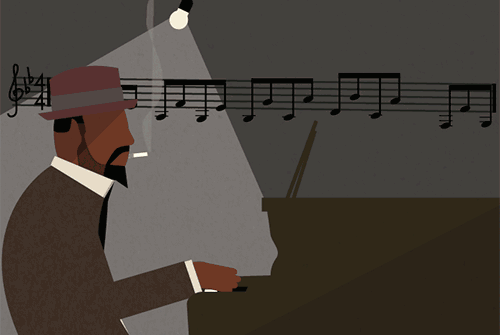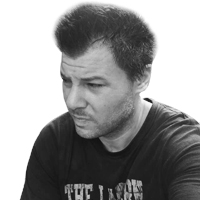Ask any group of even token jazz fans who the best composer is in the history of the medium, and a series of hearty cries will go up for Duke Ellington. But are we being wayward if we suggest that Thelonious Monk might be in the runner-up spot?
There is good reason to kick around that notion: this is Monk’s centennial year, with a zesty little Monk treat for Record Store Day on April 22 coming courtesy of the release of the 2LP set, Les liaisons dangereuses 1960—a discovery in one part, a wonder in another.
About thirty minutes of Monk music was used to score Roger Vadim’s 1960 cinematic treatment (apparently the year meant something to him, as he worked it into the title) of Pierre Choderlos de Laclos’s 1782 epistolary novel. This was when French New Wave cinema was shifting hard into avant-garde gear, virtually inventing the art house medium in the space of a couple years. The French loved jazz, and producer Marcel Romano acted as liaison for liaisons, you might say, shepherding Monk into the New Wave fold—just as he had with Miles Davis for Louis Malle’s Elevator to the Gallows in 1958.
Monk might have seemed an odd choice, despite what we now think of as his avant-garde cred—an idea that’s a touch misleading in its emphasis on how unusual Monk was. The tendency is to approach his music, conceptually, as myriad labyrinthine angles, twisting back corridors, dramatic pauses where silence hovers in the air before an unexpected chord resumes the proceedings—like something we might here with Ahmad Jamal if he possessed a devilish sense of humor and wrote like a genius savant who gave the impression of not being totally all there.
But in listening to Monk anew and making the most of this opportunity of hearing that full soundtrack session, we can see how grounded in the blues Monk was, and also how he recalibrated the possibilities of bebop to find a new, Monkian strand of those blues. In his career, Monk wrote around seventy or so compositions, a stunningly low number for someone heralded as one of the best writers in jazz. Everyone else in the discussion, it seems, wrote far more music than Monk did, and on this session he produced no new material, reaching back into his catalogue of the last several years. Ellington, conversely, wrote thousands of pieces, but Monk was more like a singular bluesman/pianist who composed when he fell into a unique set of musical and emotional circumstances that could have only birthed a Monk composition. Consequently, those numbers—and we can hear several in new castings here—are the kind of jazz songs that stick behind your ribs, inside the deepest portions of your innermost ears, the trusted byways of your head, and the secret passages of your heart, always sounding off again and again at every opportunity.
So what, exactly, is the nature of this singular document? We have Monk and a short-lived band being recorded live-in-the-studio on July 27, 1959. If you’re coming from the rock medium, think of this like a Peel session, sans the broadcast bit. Monk, simply—which is also to say, not very simply—was doing his thing; in other words, he hadn’t sat down with a rough print of the film to give great pondération to how his music might accentuate a scene or some character’s development. He was, in a sense, lengthening his particular brand of blues: slowing down tempos that were never very fast for starters, lending the music the quality of a wide-angle master shot taking in every character at once—only here the characters are emotions rather than up-to-no-good French hipsters in a New Wave film.
There is a sacral quality to the way Monk treats the blues-based, bebop textures in this recording, pulling apart musical lines and fracturing them into bridges and causeways that buckle up into latticework patterns. That’s the trick of a Monk tune like this set’s excellent rendition of “Rhythm-a-Ning”: a Monk composition just feels like more compositions at once. The Great Gatsby is 47,000 words long, but sometimes 47,000 words might as well be a million words, because each word counts for more. With Monk, each note tends to count for more.
His band is a dynamic one. Charlie Rouse, on tenor, played with Monk as long as anyone, which meant that Charlie Rouse could think jazz, you might say, with the best of them. Monk was sufficiently eccentric as a man and a composer—and even a pianist, with his unique chordal style that sought to discover bop’s essence the way one might seek to discover the essence of a peeled orange by putting its skin back on—that you would have had to have been a unique cut of cat yourself to be the man’s musical partner. Rouse and Monk made for one of jazz’s great duos, and when the former solos on “Crepuscule with Nellie”—as lovingly soulful a ballad as there is in jazz—there is a feeling of a Pied Piper leading us on to a middle-of-the-night scene where normally confusion would reign, courtesy of the darkness, but where a light of love, of fealty, here awaits instead.

It never feels like the sun comes out in a Monk song, as if we’re in some forever-Midnight Land—but with cerulean and indigo horizons, rather than enclosing blackness. Bassist Sam Jones is downright propulsive on “Well, You Needn’t,” a song which Monk had first cut for Blue Note in 1947 during one of the greatest days anyone has ever had in a recording studio. Rouse is in stud honking tenor mode, drummer Sam Jones kicks the beat hard at his kit, and you might think this is straight-up hard bop, music that could play on the jukebox and enliven any greasy 1950s bar where the drinks were cheap and the flirtation and boasting constant.
But then Monk enters for his solo, with quick clusters of notes transitioning into rhythmic chords that seem to gather up all the bits of sounds from before and present them as a living sonic palimpsest. This is easy to listen to, easier to enjoy, and dead tricky to do. Same goes with the fragmentary gospel number, “We’ll Understand it Better By and By,” a tune that perhaps emerged out of Monk’s subconscious—or his plain old Monkian consciousness—from his days on the gospel circuit as a teen.
It’s as tuneful as anything by Hoagy Carmichael, with Monk and Rouse dueting, each player trailing off just at the right moment so that the other is free to advance in that gap, that wonderful little span of trust. Some music simply says “come with me here—you’ll like it” more so than other music, which is also how seventy compositions feel like a million.





